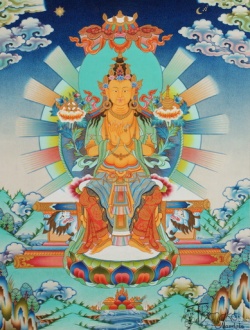Difference between revisions of "Maitreya's General description"
(Created page with "thumb|250px| Maitreya is typically pictured seated, with both feet on the ground, indicating that he has not yet completed ascending his throne, whi...") |
|||
| Line 1: | Line 1: | ||
[[File:Maitreya-012.jpg|thumb|250px|]] | [[File:Maitreya-012.jpg|thumb|250px|]] | ||
| − | Maitreya is typically pictured seated, with both feet on the ground, indicating that he has not yet completed ascending his throne, which is believed to be a style of western throne, not Indian as previously believed. He is dressed in the clothes of either a Bhiksu or Indian royalty. As a Bodhisattva, he would usually be standing, and dressed in jewels. Usually he wears a small stupa in his headdress, and could be holding a chakra wheel resting a lotus. A scarf is always tied around his waist. In the Greco-Buddhist art of Gandhara | + | [[Maitreya]] is typically pictured seated, with both feet on the ground, indicating that he has not yet completed ascending his throne, which is believed to be a style of western throne, not [[Indian]] as previously believed. He is dressed in the [[clothes]] of either a [[Bhiksu]] or [[Indian]] royalty. As a [[Bodhisattva]], he would usually be standing, and dressed in jewels. Usually he wears a small [[stupa]] in his headdress, and could be [[holding]] a [[chakra]] [[wheel]] resting a [[lotus]]. A scarf is always tied around his waist. In the Greco-Buddhist [[art]] of [[Gandhara]]n the first centuries AD in {{Wiki|northern India}}, [[Maitreya]] is represented as a Central Asian or northern [[Indian]] nobleman, [[holding]] a [[water]] phial in his left hand. He is flanked by his two acolytes, [[Asanga]] and his brother, [[Vasubandhu]]. |
{{R}} | {{R}} | ||
[http://www.mauspfeil.net/suche.html?key=maitreya www.mauspfeil.net] | [http://www.mauspfeil.net/suche.html?key=maitreya www.mauspfeil.net] | ||
[[Category:Buddhist Terms]] | [[Category:Buddhist Terms]] | ||
[[Category:Maitreya]] | [[Category:Maitreya]] | ||
Revision as of 03:32, 6 September 2013
Maitreya is typically pictured seated, with both feet on the ground, indicating that he has not yet completed ascending his throne, which is believed to be a style of western throne, not Indian as previously believed. He is dressed in the clothes of either a Bhiksu or Indian royalty. As a Bodhisattva, he would usually be standing, and dressed in jewels. Usually he wears a small stupa in his headdress, and could be holding a chakra wheel resting a lotus. A scarf is always tied around his waist. In the Greco-Buddhist art of Gandharan the first centuries AD in northern India, Maitreya is represented as a Central Asian or northern Indian nobleman, holding a water phial in his left hand. He is flanked by his two acolytes, Asanga and his brother, Vasubandhu.
